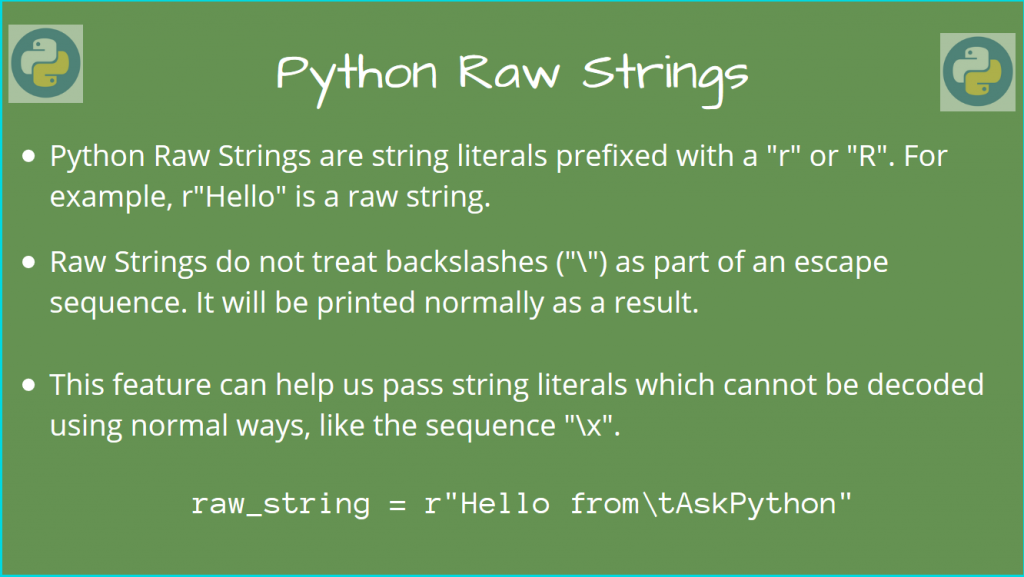Raw strings in Python are a useful yet underutilized feature. They allow you to define string literals that completely ignore escape sequences and treat backslashes literally.
This enables you to easily define strings with newlines, quote characters and other special characters that would otherwise require cumbersome escaping. Raw strings make the source code more readable and maintainable.
In this comprehensive guide, we’ll take a look at what raw strings in Python are, how they work, and some of the edge cases where you need to be cautious with using these.
Introduction to Raw Strings in Python
A Python raw string is a normal string, prefixed with a r or R. This treats characters such as backslash (‘\’) as a literal character. This also means that this character will not be treated as a escape character.
Python raw strings treat special characters without escaping them. To create a raw string, prefix it with ‘r’ or ‘R’ in front of the string. This results in escape characters like backslash (‘\’) being treated as a literal character. Raw strings are useful in scenarios when standard Python strings don’t work.
Let’s now look at using raw strings, using some illustrative examples!
Also read: 4 Handy Ways to Convert Bytes to Hex Strings in Python 3
Understanding and Using Python Raw Strings
To understand what a raw string exactly means, let’s consider the below string, having the sequence “\n”.
s = "Hello\tfrom AskPython\nHi"
print(s)
Now, since s is a normal string literal, the sequences “\t” and “\n” will be treated as escape characters.
So, if we print the string, the corresponding escape sequences (tab-space and new-line) will be generated.
Hello from AskPython
Hi
Now, if we want to make s as a raw string, what will happen?
# s is now a raw string
# Here, both backslashes will NOT be escaped.
s = r"Hello\tfrom AskPython\nHi"
print(s)
Here, both the backslashes will not be treated as escape characters, so Python will not print a tab-space and a new-line.
Rather, it will simply print “\t” and “\n” literally.
Hello\tfrom AskPython\nHi
As you can see, the output is just the same as the input, since no characters are escaped!
Also read: Regular Expression for a String With Certain Condition
Raw Strings in Challenging Cases
Now, let’s look at another scenario where raw strings can be exceptionally useful, especially when Python strings fall short.
Consider the below string literal, having the sequence “\x”.
s = "Hello\xfrom AskPython"
print(s)
Here, the sequence “\x” cannot be decoded using the standard unicode encoding.
SyntaxError: (unicode error) 'unicodeescape' codec can't decode bytes in position 5-7: truncated \xXX escape
This means that we cannot even put it into a string literal. What can we do now?
This is where raw string come handy.
We can easily pass the value into a variable, by considering it as a raw string literal!
s = r"Hello\xfrom AskPython"
print(s)
Now, there is no problem, and we can pass this raw string literal as a normal object!
Hello\xfrom AskPython
NOTE: In some cases, if you’re printing a Python raw string on the console, you may get something like this:
>>> r"Hello\xfrom AskPython"
'Hello\\xfrom AskPython'
This is just Python’s representation of the stored string. When the actual string is printed using print(), the raw string literal is correct.
Advantages and Disadvantages of Raw Strings
Raw strings undoubtedly have their benefits, but they also come with certain disadvantages. Let’s examine the pros and cons of using raw strings in Python.
Pros
- Simplified Syntax: With raw strings, you can avoid the complications resulting from escape sequences, making it easier to deal with file paths, regular expressions, and other situations where special characters are common.
- Enhanced Readability: By treating special characters as literal characters, raw strings promote readability and reduce the likelihood of misinterpretations.
- Reduced Errors: Eliminating the need to escape special characters in raw strings helps prevent errors associated with incorrect escape sequences or forgotten backslashes.
Cons
- Limited Use Cases: Raw strings are not always suitable, as they don’t support all escape sequences. For instance, they cannot handle a quote character inside the string or end with an odd number of backslashes.
- Compatibility Issues: Raw strings do not support certain Unicode sequences, which may hinder compatibility and seamless processing with other programming languages and libraries.
Summary
Python raw strings provide a convenient approach to handle special characters without the need for escaping them. This can save both time and effort, especially in complex cases where regular Python strings struggle to achieve the desired output. Next time you encounter issues with escape characters, will you consider using raw strings in your Python code?
Also read:
